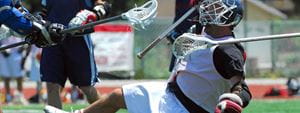
Dear Doc:
My 16-year-old son was recently knocked to the ground by a six foot, 200-pound defenseman in a high school lacrosse game. Although he was wearing a helmet, he was woozy after the hit and had a headache. Afterwards, he was diagnosed with a concussion. Can you tell me more about concussions and what to expect?
Answer:
Dear Reader:
You, I am sure, share my fears of being the parent of a teenager. On average, teens text 3,339 times per month, are three times more likely to be in a fatal motor vehicle accident, and will potentially be paying more than $100,000 for a college education. It goes without saying that they also believe they will always know more than their parents despite their young age. We both share the excitement and pride of having a high school athlete in the family. With the positives of sports comes the risk of injury. High school athletes suffer two million injuries, 500,000 doctor visits, and 30,000 hospitalizations each year.
It is estimated that 400,000 of the estimated two million plus concussions that occur each year are in children. It is estimated that five to ten percent of athletes will experience a concussion in any given sports season. It is important to realize that fewer than ten percent of sport related concussions involve loss of consciousness or blacking out.
Concussion is derived from the Latin “concutere” which means “to shake violently” and is the most common type of traumatic brain injury. A concussion is a short loss of normal brain function in response to a head injury. Your brain is a soft organ that is surrounded by spinal fluid and protected by your hard skull. This spinal fluid acts like a cushion that keeps your brain from banging into your skull. A concussion occurs after a blow to the head, a fall, or other injury that violently shakes the brain. In such cases the trauma is severe enough that the spinal fluid is unable to cushion the brain and injury results. You do not have to pass out to have a concussion.
Symptoms of a concussion may be immediate or may not start for days or weeks after the injury. Symptoms may include a headache, nausea, dizziness and/or fatigue. A feeling of being dazed and trouble concentrating is often reported. More serious symptoms that require immediate care include seizures, decreased coordination, vomiting, confusion and slurred speech.
Any person who may have had a concussion should seek medical attention. Medical providers will do a complete history, physical and neurologic exam. Questions to test memory and the ability to pay attention will be part of the exam. Sometimes imaging of the brain through a CAT scan or MRI will be ordered to make sure the brain is not bruised or bleeding. Any person with a concussion should be monitored for worsening symptoms.
Rest, both physical and mental, is the best way to recover from a concussion. This includes limiting physical activity, driving, school work, video games and even texting! Getting plenty of sleep, avoiding alcohol, and limiting stress are recommended. Ice packs, pain medications and other supportive treatments may also be prescribed. Some people will feel normal again in a few hours, while others may have symptoms for weeks or months. Most make a full recovery but if recurrent injury occurs prior to the brain being healed or if multiple concussion occur, permanent brain injury may occur.
For athletes there are strict guidelines when one can “return to play.” These guidelines have been developed by experts and following these guidelines ensures an athlete does not put his or her brain health in jeopardy. The athlete must have completed physical and cognitive rest and not be experiencing any concussion symptoms for a minimum of 24-hours before starting on the “return to play” guidelines. The athlete is gradually allowed to increase physical activity in a five step progression while being monitored by a health care provider or trainer that has experience in concussions. It may take anywhere from several weeks to months to work through the five step “return to play” progression depending on degree of injury and symptoms.
I wish you and your teenage son well. Work with your son’s health care provider and follow the “return to play” guidelines and your son should be texting, driving, and hopefully dodging large defensive lacrosse players very soon!
Stay healthy, and remember the quote by Jeffrey Eugenides, “Biology gives you a brain. Life turns it into a mind.”
Dr. Nagpaul is a medical doctor and is board certified in Internal Medicine. He currently is the Medical Director at Newark-Wayne Community Hospital, DeMay Living Center and Wayne County Public Health. This column is meant to be educational and not intended to be used to make individual treatment decisions. Prior to starting or stopping any treatment, please confer with your own health care provider.